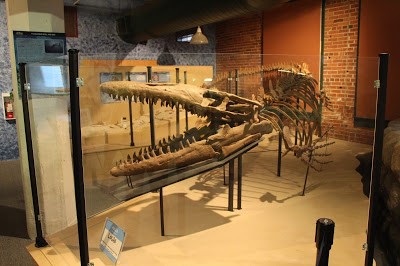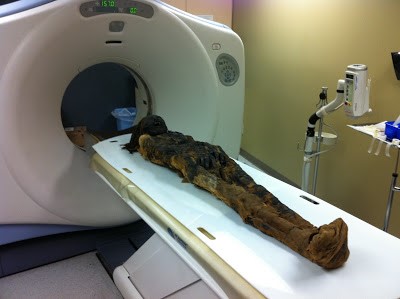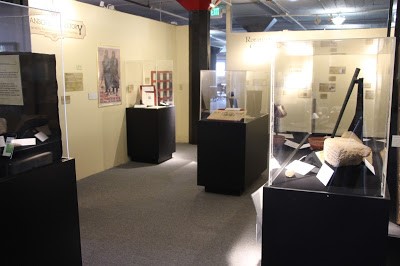History of the Museum Part 3
June 20, 2016

IMPORTANT NOTICE: Due to the exciting recent acquisition of almost 200 artifacts that directly relate to the Museum’s upcoming exhibit, Forgotten Heroes: Conflict in Korea, 1950-1953, scheduled to open on June 30, 2016, the exhibit opening is postponed to allow our curator time for adequate research. We hope to have this event rescheduled for the fall, and an announcement will be made in the near future. Please check our Website, Facebook, Instagram, or Twitter for the latest updates and details.
The Museum Takes its Current Form
While the exhibits were being regularly renovated, other changes were happening. First, MOWT acquired one more large fossil. This time it was a Tylosaurus which belongs to a group of marine reptiles called mosasaurs. Our Tylosaurus was found in Logan County, Kansas and was excavated by Alan Komrosky, one of the same paleontologists who worked on Ivan. He installed the Tylosaurus in the Museum by May 8th, 2010 when Sea Creatures of the Plains opened. This exhibit focused on the new Tylosaurus specimen and fossils from Kansas.
|
|
|
Figure 1 |
Since Kansas was part of a shallow sea called the Western Interior Seaway, the exhibit contains a lot of marine fossils. Figure 1 shows Logan as he appeared shortly after installation. At the time Logan was installed, Alan hadn’t finished preparing Logan’s skull, so a cast was temporarily put in its place. Figure 2 shows Logan as he is today with his skull composed of real fossil. The cast is still in the Museum.
|
|
|
Figure 2 |
While museums are usually most noted for the exhibits that they display to the public, their objects can also be used in research. In January 2011, the Museum had been contacted by a group of doctors who were studying cardiovascular diseases in ancient peoples. They were gathering a lot of mummies to use as their sample and contacted the Museum to see if it were willing to have its mummies included in that research. The Museum staff agreed and so the mummies were brought to the Wichita West Minor Care Clinic so that they could be CT scanned. Figure 3 shows Braided Haired Lady as she was about to go through the machine. The images from the scans were then passed on to the doctors who used that information in their research. They published their article, “Atherosclerosis across 4000 years of human history: the Horus study of four ancient populations,” in The Lancet on March 10, 2013.
|
|
|
Figure 3 |
In October 2011, Tim Howard replaced Amber Javers as the Curator of Exhibits and Research. Tim began designing exhibits that had cases integrated into the walls and displays. Romancing the West, which opened September 8, 2012, was the first exhibit to use built-in cases extensively. Another change that was taking place was a move from fluorescent lighting to track lighting. The Museum staff realized the amount of lighting in the Museum was too high and needed to be reduced for the sake of the artifacts. Part of this move was to light the exhibits entirely with spot lights. The amount of fluorescent lighting has been greatly reduced in the Museum since 2011.
Tim restarted the Rotating Gallery in 2012 when a temporary exhibit, Lock, Stock, and Barrel: A Brief Evolution of Firearms and Warfare opened on March 15, 2012. The exhibit was curated by Chris Thome, a student at Wichita State University. Under Tim’s guidance, Chris chose the theme, designed the exhibit, did research, and wrote signs. From this point, every exhibit in the Rotating Gallery lasted a year and was designed by a Student Curator. Later temporary exhibits added new elements to the space, including new logos for the exhibits and LED track lighting. A more recent rotating exhibit, Transcribing History: Pictographs, Parchments, and the Printing Press, can be seen in Figure 4.
|
|
|
Figure 4 |
The final big change to the exhibits was case lighting. Tim began putting small lights inside the custom cases. This helped cut down on glare and make the objects more visible. The first exhibit to utilize case lighting was Form and Function: Making a Living in the Cenozoic. Since then, every permanent exhibit has utilized case lighting. In later exhibits, such as Creating the Crown and Through the Lens, every case was a custom case and they all had internal lighting. An example of the built-in cases and the case lighting in Creating the Crown can be seen in Figure 5.
|
|
|
Figure 5 |
In 2012, two notable changes happened in the Collections Department. The first is that Steven King replaced LaWanda Smith as Curator of Collections in October. The second thing that happened was: by the end of December, 50% of the objects in the Museum were owned by the Museum. This change from a collection that was mostly on loan to one that was mostly owned by the Museum was a major objective for LaWanda and her team.
In 2014, the Museum took part in its second Museum Assessment Program (MAP). This time, it was focused on Collections Management. The MAP reviewer was Jackie Hoff, the Director of Collections Services at the Science Museum of Minnesota. Her recommendations inspired the Museum staff to make large scale plans for their departments. First, Steven King was inspired to expand curatorial. Jackie Hoff said that the current curatorial storage room is too small and that it needs to at least double in size in order to accommodate all of the artifacts that are kept in it. That room is important because the Museum now has 9,918 objects in its collection and nearly 70% of those are not on display! Kristin Martin, the current Director of Education, revised her vision for the CAC to include an activity room that could be used for the hands-on portion of tours, camp-ins, and other student focused activities. Large scale changes on the third floor made it necessary to start talking with the whole staff about the renovations.
The end of 2014 saw a major milestone for MOWT. Prior to 2014, operating and lease agreements with the City of Wichita were only for the duration of a year. On December 2, the Wichita City Council approved a new operating agreement and lease with MOWT. This new agreement was for 25 years. The new lease is a huge relief and moral boost to the Museum staff.
2015 saw several more milestones at MOWT. The year started with a Board Retreat to discuss ideas for a strategic plan for the Museum. The retreat helped identify what issues the Museum needed to address and what the Museum could improve. At the end of the retreat, four committees, comprised of both Board members and the staff, were created to address the top four issues.
Tim began contacting architects to discuss the proposed renovations for the third floor. Schaefer, Johnson, Cox, Frey (SJCF) Architecture was chosen as the one that the Museum wanted to work with. They created some architectural drawings based on this input and these drawings were used on November 19, 2015 at an event at the Museum called Penny for Your Thoughts. The event was a huge success and there was a lot of support for these changes. In order for the Museum to make such large changes, the Museum would need to have better funding.
Well before the Penny for Your Thoughts event, Mike Noller recognized that the Museum needed to improve its funding and support. He worked with Rachel Stanley-Williams to create a Development Department. In October, Crystal Neihoff was hired as the Development Director.
One final thing that happened in 2015 is that in September the first academic article written by a Museum staff member was published. The team at MOWT plays such a big role in making the Museum what it is. A picture of the team taken outside of the Museum on December 23, 2015 is shown in Figure 6.
|
|
|
Figure 6 |
In the back row, from left to right, are: Chris Discipio: Customer Services Representative, Tim Howard: Curator of Exhibits and Research, Mike Noller: President and CEO, Dillon Noller: Operations Assistant, Steven King: Curator of Collections and Staff Paleontologist
In the front row, from left to right, are: Tracy Dickson: Operations Director, Crystal Neihoff: Development Director, Kristin Martin: Education Director, Jordan Page: Marketing Assistant
Future Changes for the Museum
Here in 2016, MOWT is on the brink of change once again. The end of 2015 left the Museum with new plans, and new directions. Some changes are already scheduled such as a long overdue curatorial storage expansion and the acquisition of new shelves and cabinets. These improvements will require support from the community. The support from their visitors is already there: the Museum of World Treasures is the highest rated museum in Wichita on Tripadvisor. We need your continued support. MOWT is a treasure for Wichita so don’t forget to do your best for your Museum.
The Museum of World Treasures will always strive to improve itself. New artifacts will be obtained. Permanent exhibits will always have to be improved and touched up and rotating galleries will always allow for new exhibits.




